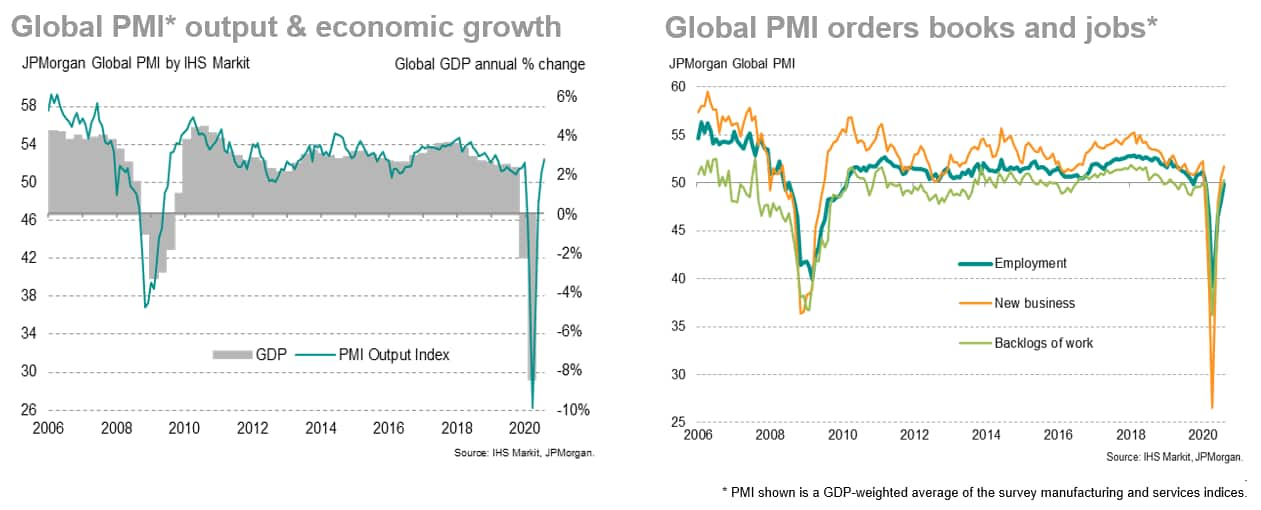Customer Logins
Obtain the data you need to make the most informed decisions by accessing our extensive portfolio of information, analytics, and expertise. Sign in to the product or service center of your choice.
Customer Logins
ECONOMICS COMMENTARY
Sep 08, 2020
Global growth accelerates but virus worries cloud outlook
The following is an extract from IHS Markit's monthly PMI overview presentation. For the full report please click on the link at the bottom of the article.
The worldwide PMI surveys signalled the fastest global growth for nearly 1½ years in August led by rebounding activity from COVID-19 lockdowns. The JPMorgan Global PMI™ (compiled by IHS Markit) rose for a fourth successive month in August, up from 51.0 in July to 52.4 in August, its highest since March 2019. The improved reading indicates a near-3% annual rate of GDP expansion.
The faster growth of global output was accompanied by the strongest monthly rise in new business since January, reflecting firmer client demand. Encouragingly, the rise in new work led to an increase in backlogs of work. Although only marginal, the rise in backlogs hints that global operating capacity was stretched on average for the first time since February. The increase in order books caused more firms to take a more positive view of payroll numbers, with the net loss of jobs in August only marginal and the smallest since global employment began falling back In February.
Chris Williamson, Chief Business Economist, IHS
Markit
Tel: +44 207 260 2329
chris.williamson@ihsmarkit.com
© 2020, IHS Markit Inc. All rights reserved. Reproduction in whole
or in part without permission is prohibited.
Purchasing Managers' Index™ (PMI™) data are compiled by IHS Markit for more than 40 economies worldwide. The monthly data are derived from surveys of senior executives at private sector companies, and are available only via subscription. The PMI dataset features a headline number, which indicates the overall health of an economy, and sub-indices, which provide insights into other key economic drivers such as GDP, inflation, exports, capacity utilization, employment and inventories. The PMI data are used by financial and corporate professionals to better understand where economies and markets are headed, and to uncover opportunities.
This article was published by S&P Global Market Intelligence and not by S&P Global Ratings, which is a separately managed division of S&P Global.
{"items" : [
{"name":"share","enabled":true,"desc":"<strong>Share</strong>","mobdesc":"Share","options":[ {"name":"facebook","url":"https://www.facebook.com/sharer.php?u=http%3a%2f%2fprod.azure.ihsmarkit.com%2fmarketintelligence%2fen%2fmi%2fresearch-analysis%2fglobal-growth-accelerates-but-virus-worries-cloud-outlook-sep20.html","enabled":true},{"name":"twitter","url":"https://twitter.com/intent/tweet?url=http%3a%2f%2fprod.azure.ihsmarkit.com%2fmarketintelligence%2fen%2fmi%2fresearch-analysis%2fglobal-growth-accelerates-but-virus-worries-cloud-outlook-sep20.html&text=Global+growth+accelerates+but+virus+worries+cloud+outlook+%7c+S%26P+Global+","enabled":true},{"name":"linkedin","url":"https://www.linkedin.com/sharing/share-offsite/?url=http%3a%2f%2fprod.azure.ihsmarkit.com%2fmarketintelligence%2fen%2fmi%2fresearch-analysis%2fglobal-growth-accelerates-but-virus-worries-cloud-outlook-sep20.html","enabled":true},{"name":"email","url":"?subject=Global growth accelerates but virus worries cloud outlook | S&P Global &body=http%3a%2f%2fprod.azure.ihsmarkit.com%2fmarketintelligence%2fen%2fmi%2fresearch-analysis%2fglobal-growth-accelerates-but-virus-worries-cloud-outlook-sep20.html","enabled":true},{"name":"whatsapp","url":"https://api.whatsapp.com/send?text=Global+growth+accelerates+but+virus+worries+cloud+outlook+%7c+S%26P+Global+ http%3a%2f%2fprod.azure.ihsmarkit.com%2fmarketintelligence%2fen%2fmi%2fresearch-analysis%2fglobal-growth-accelerates-but-virus-worries-cloud-outlook-sep20.html","enabled":true}]}, {"name":"rtt","enabled":true,"mobdesc":"Top"}
]}





